Antibacterial properties of triclosan
Introduction
The chemical name of triclosan is 5-chloro-2-(2',4'-dichlorophenoxy)phenol, the chemical formula is C12H7Cl3O2, and it is an organic compound. Triclosan is a broad-spectrum antibacterial agent that is widely used in household chemicals such as soap and toothpaste, and has also been detected in human breast milk or urine. The melting point of triclosan is 55-57°C and the boiling point is 120°C[1].

Picture 1 Triclosan powders
Physical state
Triclosan is a slightly aromatic high-purity white crystalline powder; Solubility: slightly soluble in water, moderately soluble in dilute alkali, has high solubility in many organic solvents, in water-soluble solvents or surfactants After dissolving, it can be made into a transparent concentrated liquid product[2].
Stability of triclosan
It has excellent storage stability: it will not decompose rapidly below 280-290 °C; only 2% of the active substances will decompose when heated at 200 °C for 14 hours, and only slightly decomposed even under long-term ultraviolet light irradiation. Its solution is stable to acid and alkali. Volatility: very low volatility, slightly aromatic.
Low toxicity profile of triclosan
The LD50 of oral triclosan in mice is about 3800mg/kg, which is a low-toxic substance. It is rapidly catabolized in the environment and generally does not cause environmental problems. Triclosan is a broad-spectrum antibacterial agent, highly effective, safe, and widely used as an active ingredient in cosmetics, detergents, medical disinfection and health care products.
Antibacterial properties
On August 6, 1998, Dr. Stuart Levy of Tufts University in the United States wrote in the journal Nature that triclosan antibacterial agents can effectively inhibit harmful bacteria: Escherichia coli, Staphylococcus aureus, Candida albicans, while protecting beneficial bacteria. According to the work of Dr. Peter Gilbert in the UK, Dr. Levy's experiments proved that triclosan does not cause bacterial resistance. This is supported by at least seven peer-reviewed and published papers, including one co-authored by Dr. Levy himself, published in Antimicrobial Agents and Chemotherapy in August 2004. Triclosan breaks down rapidly in nature, so the chance of developing resistance problems is low. Triclosan is a high-efficiency broad-spectrum antibacterial agent, which can kill and inhibit Gram-positive bacteria, negative bacteria, yeast and viruses.
Scope of application
Triclosan is widely used in high-efficiency medicinal soap/sanitary soap, sanitary lotion, deodorant/foot aerosol, disinfectant hand sanitizer, wound disinfectant spray, medical device disinfectant, sanitary facial cleanser/ointment, air freshener and refrigerator deodorant It is also used in the finishing of sanitary fabrics and the preservative and treatment of plastics. The higher purity triclosan is also widely used in toothpaste and mouthwash for the treatment of tooth plow, periodontitis and oral ulcers. The recommended concentration is 0.05%-0.3%. Triclosan is generally stored in a sealed, dry and dark place, and the storage temperature should not exceed 40 ℃
Chemical Products
In the U.S., triclosan is primarily produced at the U.S. plant of Ciba Specialty Chemicals, a Swiss company that uses Irgasan DP300 (Yujiexin DP300) as the trade name. In China, major manufacturers of triclosan generally use triclosan directly as the trade name. In other countries and regions, triclosan usually has the following trade names: CH-3565 Triclosan CH 3635 Irgasan Ch 3635 Irgasan DP 300 Lexol 300 Ster-Zac. TCS Triclosan Triclosan Triclosan Kelien Jiemeixin Antibacterial pure Yujiexin DP300 Weijieling-100 Weijie pure. Specifications Product specifications: content ≥99% melting point 93-98 ℃. Color off-white or white crystal Loss on drying ≤0.5%. Ignition residue ≤0.1% Heavy metal ≤20PPM.
Effect
Triclosan is widely used in high-efficiency medicated soap (sanitary soap), sanitary lotion), deodorant (foot aerosol), disinfectant hand sanitizer, wound disinfection spray, medical device disinfectant, sanitary facial cleanser (cream), air freshener It is also used in the finishing of sanitary fabrics and the antiseptic treatment of plastics. The higher purity Klein is also widely used in toothpaste and mouthwash for the treatment of gingivitis, periodontitis and oral ulcers. The recommended concentration is 0.05% to 0.3%.
Carcinogenic controversy
At present, there is still controversy about whether triclosan is carcinogenic to humans, and there is not enough evidence to confirm its carcinogenicity to humans. It was reported earlier that long-term exposure to triclosan would induce liver cirrhosis in mice, and the 2014 PNAS article reported it again Triclosan has the effect of promoting liver tumor, and the journal Science in 2016 also proposed the hepatotoxic effect of triclosan. my country's mandatory national standard (GB22115-2008) promulgated in 2008 for raw materials for toothpaste stipulates that triclosan is allowed to be added to toothpaste, but the content should not exceed 0.3%.
Reference
1 Li Linpeng, Ma Huimin, Hu Junjie, etc. Study on DNA damage of human hepatocytes by triclosan and triclocarban. 2010
2 Zhou Shibing, Zhou Xuefei, Zhang Yalei, Shi Lu. Research progress on the existence, behavior and migration and transformation of triclosan in water environment. 2008
You may like
See also
Lastest Price from Triclosan manufacturers

US $0.00-0.00/kg2025-07-22
- CAS:
- 3380-34-5
- Min. Order:
- 1kg
- Purity:
- 99%
- Supply Ability:
- 20MT

US $10.00/kg2025-04-21
- CAS:
- 3380-34-5
- Min. Order:
- 1kg
- Purity:
- 99.5%
- Supply Ability:
- 100 TON


